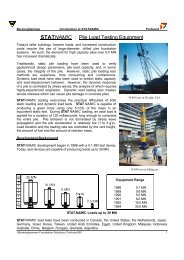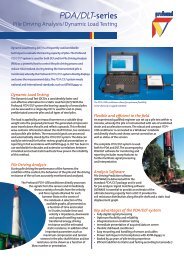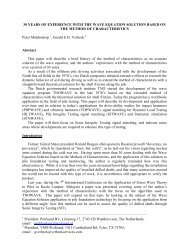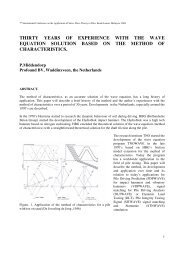When to apply DLT and Statnamic.pdf - Profound BV
When to apply DLT and Statnamic.pdf - Profound BV
When to apply DLT and Statnamic.pdf - Profound BV
Create successful ePaper yourself
Turn your PDF publications into a flip-book with our unique Google optimized e-Paper software.
2nd <strong>Statnamic</strong> Seminat, Tokyo, 1998 8<br />
To mobilize the pile capacity a STN device will be sent <strong>to</strong> the building site with at least a corresponding<br />
loading capacity. Only when the piles are overdesigned will the full bearing capacity not be mobilized.<br />
Table . Preferences with respect <strong>to</strong> set up phenomena <strong>and</strong> mobilization of capacity<br />
Driven piles<br />
Soil set up <strong>DLT</strong> STN Preferred method<br />
low <strong>to</strong> medium ***** ***** <strong>DLT</strong>/STN<br />
medium <strong>to</strong> high ** ***** STN<br />
***** = capacity fully mobilized<br />
* = capacity not mobilized<br />
• Chance of pile damage<br />
For <strong>DLT</strong> the are some cases with a chance of pile damage. In the case of low friction <strong>and</strong> a soft <strong>to</strong>e<br />
response tension waves will be generated during <strong>DLT</strong>. <strong>When</strong> the maximum allowable tension stresses are<br />
reached the load on the pile cannot be increased because this will generate higher tension stresses <strong>and</strong> the<br />
pile will experience damage. In the case of a pile with a hard <strong>to</strong>e response, for example pile <strong>to</strong>e on rock,<br />
the compressive stresses at the pile <strong>to</strong>e can theoretically be two times higher than the maximum<br />
compression stress at the pile head. This is caused by the superposition of compression stress waves at<br />
the pile <strong>to</strong>e. So, if during <strong>DLT</strong> the compression stresses at the pile head are higher than half the<br />
compressive strength of the pile material, collapse of the pile material at the pile <strong>to</strong>e will occur. In this<br />
case piles can only be tested up <strong>to</strong> half the compressive strength of the pile material, which may not<br />
correspond with the capacity of the pile.<br />
For STN the pile is kept under constant compression <strong>and</strong> tension waves are suppressed. Superposition of<br />
compression waves at the pile will not occur. As with SLT piles can be tested near <strong>to</strong> the compressive<br />
strength of the shaft.<br />
Preferences with respect <strong>to</strong> soil resistance <strong>and</strong> pile material stresses<br />
Driven piles<br />
Soil resistance Tension stresses Compression stresses<br />
shaft friction<br />
<strong>to</strong>e <strong>DLT</strong> STN <strong>DLT</strong> STN Preferred method<br />
resistance<br />
low <strong>to</strong> medium soft xxxxx x *** *** STN<br />
medium <strong>to</strong> stiff soft xxxx x *** *** STN<br />
low <strong>to</strong> medium medium xx x *** *** <strong>DLT</strong>/STN<br />
medium <strong>to</strong> stiff medium xxx x *** *** <strong>DLT</strong>/STN<br />
low <strong>to</strong> medium high xxx x ***** *** <strong>DLT</strong>/STN<br />
medium <strong>to</strong> stiff high xxxxx x ***** *** STN<br />
xxxxx - high tension stresses ***** - medium compression stresses<br />
x - no tension stresses * - high compression stresses









